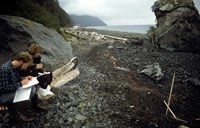
Injury
The Exxon Valdez spilled approximately 11 million gallons of crude oil into Prince William Sound, and much of this oil washed up on shores and was deposited in intertidal and subtidal zones of the Spill area. Intertidal shorelines captured approximately 40 - 45 percent of the oil, and up to 13 percent of the oil settled in subtidal habitats. Using a variety of methods, manual removal eliminated some of the oil from the intertidal zone early in the response phase, and within a few months of the Spill, 89 percent of the moderately to heavily oiled beaches had been treated. Clean-up activities also occurred in 1990 and 1991. According to Shoreline Clean-up Assessment Team (SCAT) surveys, by 1992, approximately 10 km of the original estimated 583 km beaches with surface oiling remained uncleaned. The SCAT surveys were focused on documenting surface oiling as a way to direct clean-up activities. Therefore, subsurface and subtidal oil was not as closely monitored.
 Recovery Objective
Recovery Objective
Sediments will have recovered when there are no longer significant residues of Exxon Valdez oil on shorelines (both intertidal and subtidal) in the Spill area. Declining oil residues and diminishing toxicity are indications that recovery is underway.
Recovery Status
Approximately 10 acres of Exxon Valdez oil remains in surface sediments of Prince William Sound, primarily in the form of highly weathered, asphalt-like or tar deposits. In 2003, it was estimated that 20 acres of unweathered, lingering oil may still be present in subsurface, intertidal areas of the Sound, which could represent up to 100 tons of remaining oil. Most of this oil is found in protected, unexposed bays and beaches. Subsurface oil was not subjected to the original clean-up activities, and because this oil is trapped beneath a matrix of cobbles, gravel and finer sediments, it is not easily exposed to natural weathering processes.
The most recent studies documenting residual oil occurred on those beaches that were considered heavily or moderately oiled in 1989. Beaches reported as lightly oiled were not surveyed. Moreover, beaches outside of the Sound were not included, so the amount and extent of residual oil in the entire Spill zone is not known, but one estimate suggests as much as 200 tons of oil may still exist. Several studies have evaluated the extent of lingering oil on armored oiled beaches along the outer Kenai Peninsula coast, the Alaska Peninsula, and Kodiak Archipelago. These studies looked at the same sites repeatedly at intervals from 1992-2005. By 1995, little visible oiling was observed in the study area on Kodiak. Overall, by 1995, hydrocarbon concentrations in sediments at the Gulf of Alaska sites were generally lower than for sites in Prince William Sound, but at some locations substantial concentrations persisted. Through 2005, surface oil was not frequently observed in these areas, and subsurface oil was present as mostly unweathered mousse.
In 1989, chemical analysis of oil in subtidal sediments was conducted at a small number of index sites in Prince William Sound. In the subtidal areas, petroleum hydrocarbon concentrations were highest at depths of 1-60 feet (below mean low water) and diminished out to depths of 300 feet. It is likely that oil in subtidal sediments have decreased substantially since the Spill. In 2001, several sites that were sampled after the Spill were re-visited, and no oil was found in the subtidal sediment from these locations.
Twenty-one years after the Spill, lingering oil has persisted in the intertidal zones of Prince William Sound and on northwest shorelines of the Spill area. The presence of subsurface oil continues to compromise wilderness and recreational values, expose and potentially harm living organisms, and offend visitors and residents, especially those who engage in subsistence activities along still-oiled shorelines. Although much of the oil has diminished over time, pockets of unweathered oil exist, and natural degradation of this oil is very slow. Moreover, some obligate intertidal foraging bird species are still being exposed to oil.
Therefore, sediments are considered to be RECOVERING.
Click HERE for more information on Trustee Council funded studies of sediments.
